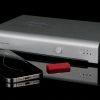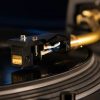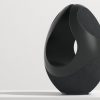Consider Adding Surround Sound to Your Stereo System
Don’t be a stubborn stick-in-the-mud or Luddite if you’ve been listening to stereo (two channels) for 20 years or more and think that’s as good as it gets. Our amazing hearing system and brain hears and processes sound in 360 degrees, but we are especially sensitive to sounds from the front and from each side (a bit less to sounds from above and behind us). The real-life reflections that we hear from all directions in concerts, halls, clubs and stadiums can’t begin to be accurately reproduced by 2-channel stereo using two loudspeakers. Once you hear your stereo CDs or Dolby Digital 5.1-channel movie soundtracks reproduced through five channels and a subwoofer, you’re swept into a whole new level of musical realism. Nor is it limited to modern DVD or HDTV Dolby Digital 5.1-channel soundtracks, because Dolby, dts and Logic7 processors will recover the ambient reflections from your 2-channel CDs and route them to the surround speakers where they belong. Dolby Pro LogicIIx, dts Neo:6 and Logic7 work equally well for rock, jazz or grand opera. You’ll listen to your entire collection of stereo CDs again to see how they “decode” into six or more channels. And for those who have recently “discovered” vinyl, it works just as well with stereo LPs.
Install a Subwoofer for Deep Thrilling Bass in Music and Movies
The best floor-standing speakers, while often capable of very good deep bass, simply don’t have large enough enclosures, hefty woofers and big mega-watt amplifiers to plumb the depths of the musical spectrum and subsonic regions the way a dedicated subwoofer can. Subwoofers can add profoundly satisfying reinforcement to music or movie soundtracks that you may find absolutely thrilling. At first it may seem contradictory to put an additional dedicated speaker into your room just for deep bass, but once heard, you’ll never go back. Deep bass forms the musical foundation for most classical and rock music, and movie soundtracks take on a new dimension. Wait till you hear the sound of the pods in the remake of “War of the Worlds” with a new subwoofer attached to your system. If you are a classical fan, orchestral bass drums in a big orchestra or pipe organ acquire tremendous impact. Many enthusiasts are so awed by the sound of one subwoofer, they often add a second subwoofer to smooth out the deep bass for all listening seats in a room. (See “Try a Different Subwoofer Location,” below, for more benefits of two subwoofers.)
Is It Time to Mothball Those Old Speakers and Stereo Receiver?
Loudspeakers and solid-state (transistor) electronics have amazing longevity and last a lot longer than your dishwasher, automobile, and most appliances–but they do have a finite life nevertheless. On average, electronics start to get noisy (capacitors deteriorate, controls oxidize and get intermittent) after about 12 to 15 years and speakers start showing signs of age after a dozen years or so. The foam surrounds on older speaker cones disintegrate, allowing air leaks and changes in woofer cone control. More important, the design of loudspeakers and electronics advances significantly every 5 years or so (electronics, every couple of years; with speakers audible improvements occur every five to 10 years). Electronic design has leapt ahead, with far lower prices now for multi-channel surround receivers than what you might have paid for a simple two-channel stereo a dozen years ago. Manufacturing efficiences are partly responsible, and the huge advances in integrated chips containing Dolby Digital and dts multi-channel processors have lowered prices to remarkable levels. As a teenager who built mono hi-fi preamps and amplifiers (Heathkit, Dynakit, and Eico) for my dad back in the 1950s–the age of mono (stereo arrived in 1957)–it’s astonishing to me that I can purchase a modern solid-state AV receiver with seven internal amplifiers and decoding chips that sort out all the existing and newest lossless Blu-ray soundtracks for $500 or less.
Try a Different Subwoofer Location
It may seem logical to put your subwoofer at the front of the room along with your main speakers, video display and AV furniture, but that location may not be optimal for getting deep, smooth bass at your seating area. That’s because of room modes and standing waves– different pressure regions throughout your room caused by the long bass waves interacting with the specific dimensions of the room, the sub’s location and where you sit. A subwoofer can be placed at the side or back of the room so long as you use a crossover frequency of 80 Hz (Axiom says so, and so does THX), and the bass will be non-directional. In those locations, the bass from your subwoofer may be much deeper and more powerful. You can also try relocating your couch and chairs–but in most rooms that’s more difficult than moving the subwoofer. Many subwoofer fans follow the advice of Dr. Floyd Toole, one of the world’s foremost authorities on loudspeaker sound and room interaction. He suggests (and we concur) using two subwoofers at opposite sides or opposite ends of a room. Doing so will supply profoundly deep bass to virtually every listening location, leaving no one disappointed by an absence of ultra-deep bass. Here’s a tip to help you find the best location for one or more subwoofers–Axiom’s subwoofer “crawl”.
Turn Off the Built-In Auto Equalizer in the AV Receiver
While it may seem so up-to-the-minute and “smart,” auto-equalization circuits like Audyssey and similar proprietary systems are gimmicks and may indeed make really linear, transparent, natural-sounding speakers like Axioms sound inferior. Admittedly, if you have some crummy old speakers or a disappointing Home-Theater-in-a-Box system, an auto-EQ circuit may help smooth out some of the worst irregularities. Most of these processors have an “auto-setup” function that may be useful at first, although it’s no substitute for using a separate Sound Level Meter and doing your calibration manually. FYI: Auto-setup automatically samples each speaker with a pink-noise test signal using its supplied microphone, decides if they’re “Small” or “Large”, sets the crossover frequency, the relative level of each and attempts to determine if all speakers are in phase–be warned that any type of bipolar, dipolar or multi-polar surround speaker will confuse its phase calculations. Auto-EQ measures the frequency response of each speaker using the microphone and a test signal and automatically adjusts the frequency response of the entire system to what it thinks is ideal, which may not approach smooth, balanced and natural sound quality. My recommendation? Disable or turn off the Auto EQ feature and only use Auto-setup if you don’t have the time or inclination to use a Sound Level Meter and do it manually.





























